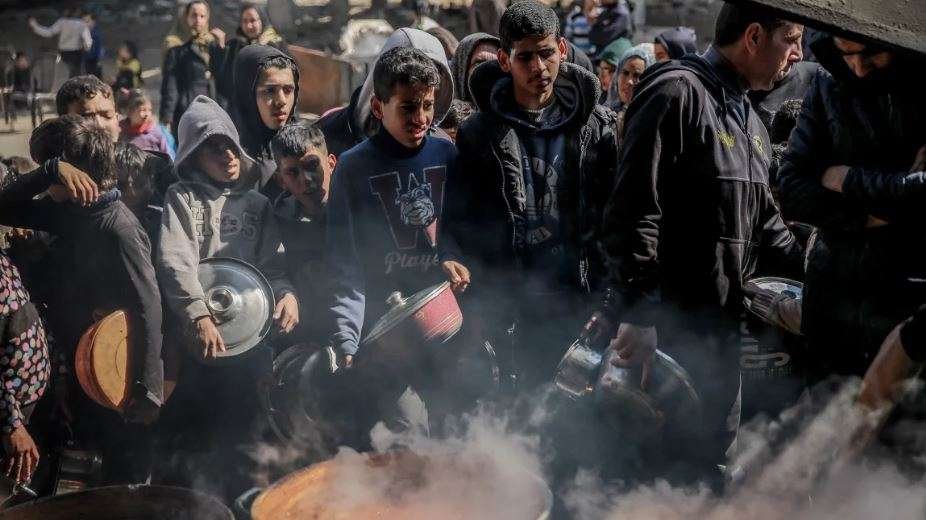President Joe Biden announced Friday that the U.S. will drop food aid into the Gaza Strip, noting that the humanitarian aid flowing into the region for Palestinians is insufficient.
“Food Aid flowing into Gaza is nowhere nearly enough… lives are on the line,” Biden said as he announced the decision about the airdrops during an Oval Office meeting he was holding with Italian Prime Minister Giorgia Meloni
“We should be getting hundreds of trucks in, not just several,” he continued. “We’re going to pull out every stop we can.”
The president reiterated that the U.S. is trying to push for an immediate cease fire between Hamas and Israel to allow more aid into Gaza, where he said “innocent people” have died.
Later on Friday, the president responded to a reporter’s question about when the first air drops will happen, saying, “I’m not positive. I think very soon.” Shortly after, Biden addressed a possible cease-fire agreement, saying he’s “still hoping for it.”
“It’s not over ’til it’s over,” he said.
Biden on Thursday had walked back his previous comments that he hoped a cease-fire agreement could be completed by Monday.
The White House is growing increasingly concerned about possible famine for a sizeable portion of Gaza’s population.
Samantha Power, the administrator of the United States Agency for International Development, announced this week that the U.S. was sending $53 million in additional humanitarian assistance into Gaza.
“She’s working on expanding the channels, the corridors through which that aid can flow. We’re going to keep at this,” White House principal deputy press secretary Olivia Dalton said Thursday. “The events of this morning just underscored how deep and dire the humanitarian needs amongst civilian population in Gaza are right now.”
The Hamas-run Gaza Ministry of Health said in a statement on Telegram Friday that 115 people had died and 760 were wounded as a crowd of people waited for humanitarian aid trucks in Gaza on Thursday. Palestinian officials claimed that Israeli soldiers opened fire on civilians.
NBC News has not independently verified the reported death toll. The Israeli military said it was reviewing the incident. An Israeli government source said that IDF troops responded with “live fire” after people surrounded trucks carrying humanitarian aid.
The Israel Defense Forces said in a post on X Thursday, “This morning humanitarian aid trucks entered northern Gaza, residents surrounded the trucks and looted the supplies being delivered. As a result of the pushing, trampling and being run over by the trucks, dozens of Gazans were killed and injured.”

“The aid workers who on the ground in Gaza are risking their lives to get food to people in desperate, desperate need, those aid workers have to be protected. They have to know they can do their jobs without being shot at and killed,” Power said on Tuesday.
Convoys have come under attack within the enclave, both “by desperate mobs” and “by criminal elements,” US envoy for Middle East humanitarian issues David Satterfield said last month.
Israeli forces targeted members of the Hamas-run police force that travels with the UN aid convoys in an effort to protect them from looting, which has led the police to stop protecting the convoys, Satterfield said.
“With the departure of police escorts, it has been virtually impossible for the UN or anyone else – Jordan, the UAE, any other implementer – to safely move assistance in Gaza because of criminal gangs,” he said.
More about Gaza Strip
The Gaza Strip is situated on a relatively flat coastal plain. Temperatures average in the mid-50s F (about 13 °C) in the winter and in the upper 70s to low 80s F (mid- to upper 20s C) in summer. The area receives an average of about 12 inches (300 mm) of precipitation annually.
Living conditions in the Gaza Strip are typically poor for a number of reasons: the region’s dense and rapidly increasing population (the area’s growth rate is one of the highest in the world); inadequate water, sewage, and electrical services; high rates of unemployment; and, from September 2007, sanctions imposed by Israel on the region.
Agriculture is the economic mainstay of the employed population, and nearly three-fourths of the land area is under cultivation. The chief crop, citrus fruit, is raised on irrigated lands and is exported to Europe and other markets under arrangement with Israel. Truck crops, wheat, and olives also are produced. Light industry and handicrafts are centred in Gaza, the chief city of the area.
Read more articles like this in our News Category.






